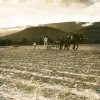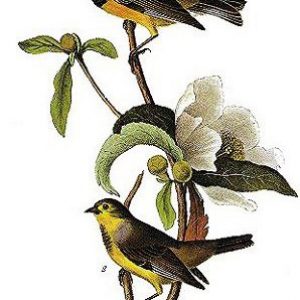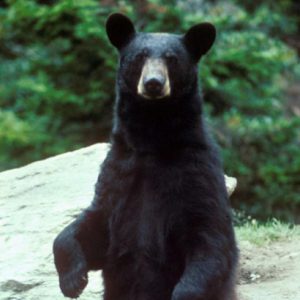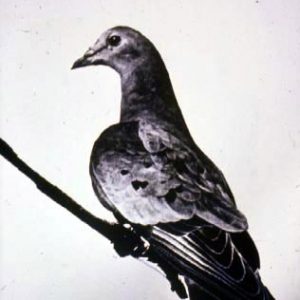calsfoundation@cals.org
Extinct Animals [Historic Period]
Arkansas has undergone many changes over geologic time. The climate has ranged from tropical, supporting dinosaurs in the Mesozoic period, to the cold period at the end of the Cenozoic period, known as the Pleistocene epoch. The most recent drastic climate change began about 1.6 million years ago during the Pleistocene epoch, the planet’s most recent ice age. Glaciers covered much of North America. They did not reach Arkansas but occurred as far south as the Missouri River. During warm periods, the glaciers melted and sent millions of gallons of water through Arkansas on its way to the sea.
Many types of animals that lived here have disappeared. If they had a hard shell or a bony skeleton, fossil records tell the story. The state’s oldest fossils are in the uplands, including the Ozark Mountains, the Arkansas River Valley, and the Ouachita Mountains. Because the land that formed the Ozarks and parts of the Arkansas River Valley was once a shallow inland sea, the rocks there are studded with the fossils of marine invertebrates. The land that formed the Ouachitas was in a deep sea basin, churning with sediment, so few fossils are found there. Fossils of larger animals, including dinosaurs, have been found in the West Gulf Coastal Plain. Shark, turtle, crocodile, and a variety of fish fossils have been found there. Chalky areas in the Southwestern Coastal Plain yield many other warm sea creatures, including bivalves and worm tubes.
The Mississippi Alluvial Plain is the best place to look for fossils of prehistoric mammals, such as the sloth, the woolly mammoth, the mastodon, saber-toothed tiger, the short-faced skunk, and the giant beaver. The great rivers that flowed during the ice age regularly flooded the Delta, depositing sediment on the alluvial plain in eastern Arkansas.
Four E’s are used to examine the status of an animal population: endemic, endangered, extirpated, and extinct. An animal endemic to the state is restricted to a location or region. It may be protected by law because its numbers are low, but the low numbers likely are related to where the animal is found. Human activity can threaten endemic species, so attempts often are made to protect the animals’ habitat. An endangered animal has been identified by the U.S. Fish and Wildlife Service as in peril of extinction.
Extirpated animals have been removed from the state but may exist elsewhere. Arkansas examples include the buffalo, the gray wolf, and the red wolf. Some are reintroduced but are not always the same species. There are sixteen recognized subspecies of the American black bear. The original species of bear in Arkansas in the nineteenth century, when Arkansas was known as the “Bear State,” was the Louisiana black bear. Overhunting, loss of habitat, and loss of food reduced the population of native black bears to fewer than fifty, in the White River National Wildlife Refuge in the Delta. In the mid-1960s, the Arkansas Game and Fish Commission reintroduced black bears to the uplands. It brought bears from Minnesota and released them in the Ozark and Ouachita mountains. By 2000, Arkansas had more than 3,000 black bears, but they were not those native to the area. The return of elk to the Ozarks is another example of an introduced species. The original elk found in Arkansas was the Eastern elk, which became extinct in the nineteenth century. The elks trumpeting around the Buffalo River today are Rocky Mountain elk.
A species is considered extinct when there is reliable documentation that it no longer exists or has died out. Since statehood in 1836, Arkansas has lost at least three bird species: the Carolina parakeet, the passenger pigeon, and the Bachman’s warbler. Many believe the ivory-billed woodpecker is also extinct.
In the early 1800s, Carolina parakeets lived in Arkansas’s bottomland forests. They were about 12″ long. Most of the bird was bright green except the head and the area between the bill and eyes, which was orange. The rest of the head and neck was yellow. They ate fruit and seeds and nested in tree cavities. The female usually laid one to four eggs and incubated them for about twenty days. The young were altricial (helpless with no down feathers) and fledged (grew feathers necessary for flight) at about twenty days. The parakeets were social birds, roosting together at night and traveling in foraging flocks. The “flocking” behavior had an impact on the extinction of both the Carolina parakeet and the passenger pigeon.
Before European settlement, the Carolina parakeet ate native fruits and seeds. As early settlers began to clear swamps and plant fruit trees, the parakeets ate that fruit, too. Huge, dense flocks could strip an orchard in hours. Besides this, the parakeets had other characteristics that made them a target of man. American Indians and Europeans prized the bright feathers. It was also valued as a caged pet bird. It sometimes could be taught to say a word or two. Its habit of roosting in flocks in hollow trees made it easy to capture large numbers by placing a sack over the opening while they slept.
Naturalist Alexander Wilson wrote of them in 1808: “When they alighted on the ground it appeared at a distance as if covered by a carpet of richest green, orange, and yellow: they afterwards settled, in one body, on a neighboring tree… covering almost every twig of it…. Having shot down a number, some of which were only wounded, the whole flock swept repeatedly around their prostrate companions, and again settled on a low tree, within twenty yards of the spot where I stood. At each successive discharge, although showers of them fell, yet the affection of the survivors seemed rather to increase.”
This flocking together and unwillingness to abandon wounded members made the birds easy targets when farmers shot them. As the area in eastern Arkansas and the rest of the bottomland forests were cleared for settlement, the parakeets declined. This bird once lived from Florida to Virginia and west to Texas. The last documented report in Arkansas was in 1885. The last flock of thirteen wild birds was recorded in 1904 in Florida. The last captive parakeet, named Incas, died in 1918 in the Cincinnati Zoo.
Scientists estimate that, at the time of European contact in the early seventeenth century, approximately a third of the birds in North America were passenger pigeons. In 1813, on a fifty-five-mile trip from Henderson to Louisville, Kentucky, John James Audubon rode under a sky darkened by a cloud of passenger pigeons. He estimated that more than a billion birds had passed over.
Primeval North America was mostly wooded east of the plains, and the huge flocks of pigeons toured the region in search of food and roosts. They spent the winter at the southern end of the forest, including Arkansas, and the summer around the Great Lakes, in New England, New York, and Ontario, Canada. Throughout the year, they lived together. The population consisted mainly of a few large flocks, groups of a billion or more that roosted in winter, migrated in spring, and nested in summer.
A nesting colony might take over fifty square miles, and every branch was loaded with nests. Up to 500 birds might nest in one tree. They roosted in piles, weighing down limbs until they snapped. Their dung buried the trunks in tons of droppings. When the flock left in spring, most of the trees would be dead.
The passenger pigeons that filled Arkansas skies were similar to the pigeons and doves we see today. They had a gray head and back, a reddish brown breast, a pale reddish brown belly, a gray central tail, and a white outer tail. They had red eyes and a wing span of about 8″. They nested in large groups, each pair building a nest of twigs. The female usually laid one egg, incubated by both parents for about thirteen days. The adults cared for the altricial young for about two weeks. To feed their hordes, the pigeons needed a large area of forest that was enjoying a year with a “mast crop,” when every oak or beech tree produced an abundance of acorns. The flocks would travel forests of the eastern United States to find areas with trees that were producing mast crops. As settlers cleared the forests, the number and size of areas that supported mast crops decreased, and the pigeons had less food. Malnourished birds do not reproduce.
Up to 1,000 men worked as professional pigeon hunters in the late nineteenth century. They traveled the country by railroad, searching for nesting grounds. One of the most notable roosts in Arkansas was near the Wattensaw community, ten miles north of Lonoke (Lonoke County). The market for pigeons was huge. The new rail lines allowed quick shipment of pigeon meat to larger cities. New York City, New York, could absorb 100 barrels a day. A barrel held 500 to 600 birds. The birds were also killed for sport.
By 1890, the wild pigeons had become rare, but many people would not believe they were gone. Some said they must have flown to Australia, while others were sure they were in Canada or South America. The last recorded wild passenger pigeon was shot in 1899, and the last living individual, an old female named Martha who lived in the Cincinnati Zoo, died on September 1, 1914.
Preferring swampy bottomland habitat, the Bachman’s warbler suffered severe population decline in the early twentieth century when that habitat began disappearing and was believed by most ornithologists since the 1960s to be extinct; it was officially declared so by the U.S. Fish and Wildlife Service in 2021.
For additional information:
Askins, Robert. Restoring North American Birds: Lessons from Landscape Ecology. Harrisonburg, VA: R. R. Donnelley and Sons, 2000.
Cokinos, Christopher. Hope is the Thing with Feathers: A Personal Chronicle of Vanished Birds. New York: Random House, 2000.
Flannery, Tim. A Gap in Nature: Discovering the World’s Extinct Animals. New York: Atlantic Monthly Press, 2001.
Smith, Kenneth L., et al. Arkansas’s Natural Heritage. Edited by Bill Shepherd. Little Rock: August House, 1984.
Weidensaul, Scott. The Ghost with Trembling Wings: Science, Wishful Thinking, and the Search for Lost Species. New York: North Point Press, 2002.
Arkansas Natural Heritage Commission


 Bachman's Warbler
Bachman's Warbler  Black Bear
Black Bear  Last Passenger Pigeon
Last Passenger Pigeon 




Comments
No comments on this entry yet.